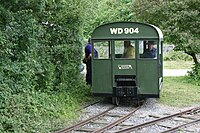Railroad speeder

A speeder (also known as a section car, railway motor car, putt-putt, track-maintenance car, crew car, jigger, trike, quad, trolley, inspection car, or draisine) is a small railcar formerly used around the world by track inspectors and work crews to move quickly to and from work sites.[1] Although slow compared to a train or car, it is called speeder because it is faster than a human-powered vehicle such as a handcar. Motorized inspection cars date back to at least 1896, when it was reported that the U.S. Daimler Motor Company created a gasoline-powered rail inspection car capable of 15 mph (24 km/h).[2]
In the 1990s, many speeders were replaced by pickup trucks or sport utility vehicles with additional flanged wheels that could be lowered for travelling on rails, called "road–rail vehicles" or hi-rails for "highway-railroad". Speeders are collected by hobbyists, who refurbish them for excursions organized by the North American Railcar Operators Association[3] in the U.S. and Canada and the Australian Society of Section Car Operators, Inc. in Australia.
Motorcar manufacturers and models[edit]


| United States | Canada |
|---|---|
|
|
Various railways and their workshops also manufactured speeders. Often these were a copy of commercially available cars, such as Wickham and Fairmont.
Dimensions[edit]
Approximate dimensions of a common speeder car are given below. Due to the variety of base models and customization these are not fixed numbers. These values are from a Fairmont A4-D.[5]
- Rail gauge: 1,435 mm (4 ft 8+1⁄2 in) standard gauge (56.5 inches)
- Weight: 3,500 pounds (1,588 kg)
- Width: 64 inches (1,626 mm)
- Height: 60 inches (1,524 mm)
- Length: 9 feet 2 inches (2,794 mm) (~110 inches)
- Wheel diameter: 16 inches (406 mm)
- Floor height: 80–120% of the wheel diameter; 11 inches (279 mm)-17 inches (432 mm)
Gallery[edit]
-
Former Queensland Rail (Australia) speeders
-
Russian GAZ-13 Chaika car converted to a speeder, preserved at the Hungarian Railway Museum
-
Deutsche Bundesbahn speeder based on the Volkswagen Type 2 light commercial vehicle
-
A battery-powered ultrasonic rail flaw detector trolley made at the Centre For Advanced Transport Engineering and Research, Western Australia
See also[edit]
Notes[edit]
- ^ Fairmont used three letters to designate car types. "S" was a Standard Series" section car; "A" was an "Advanced Series" section car and "M" was the "Master Series" section car. They also used a "category" name for motorcars. "Light Inspection" or 1-2 men, were car models: M9 nicknamed "Safe Easy", MM9, MR9, 59, M17, and MM17. "Inspection" or 1-4 men, were models "Roadmaster", M12, M16, M19 nicknamed the Safety Quick", MT19, and the 150. "Light Section" or 1-6 men, the M1, and M14 also called the "Light Section Car". "Section" or 1-8 men, were models "Dreadnaught", M2, 75, and S2. "Heavy Duty Section" or 1-8 men, the A2. "Gang" or 1-12 men, MT2, ST2, A2, AT2 and A3. "Extra Gang" or "B & B" 1-12 men, MX3, MX30G, MT2, A4, AF4, and A6. Final group, "Large Extra Gang" or "Hump" 1-12 men, models A6, A7, A8.
References[edit]
- ^ "FAQ's & Answers". NARCOA. Retrieved 2008-01-25.
- ^ Notes of the Month, The Automotor and Horesless Carriage Journal, December 1896, p103
- ^ NARCOA website
- ^ [Gunner, K., Kennard, M. 2004 The Wickham Works List Dennis Duck Publishing page?]
- ^ A-4






